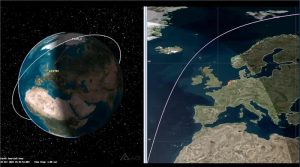
They say it marks another important step “towards making space-based connections as simple as using a mobile phone”. Previously, connections have been made with satellites in geostationary orbits. As opposed to lower-level satellites moving across a user on the ground.
“We are proud to continue to drive European technological leadership and innovation in the domain of Non-Terrestrial Networks,” said Antonio Franchi, ESA’s Head of the 5G/6G Non-Terrestrial Network (NTN) Programme Office.
“Tests such as this showcase ESA’s role in supporting the development of innovative 5G and 6G systems that unlock social and economic opportunities for people and businesses. This initiative celebrates the great collaboration between ESA, Telesat and Amarisoft!”
The idea is that LEO satellites combined with standardised 5G technology could now support services requiring real-time, interactive connections. Suggested possible applications, aside from emergency response, include support for rural healthcare and remote industrial operations worldwide.
LEO 3
The connection was from ESA’s 5G/6G laboratory at its European Space Research and Technology Centre (ESTEC). This is located in Noordwijk, Netherlands. It connected to the LEO 3 satellite operated by Telesat. The connection was made at the end of December last year.
A Memorandum of Understanding between the parties, in 2024, enabled access to the demonstration satellite. LEO 3 supports low-latency customer applications testing, as well as antenna and modem development.
Amarisoft’s 5G technology was used to establish and maintain a stable connection with the satellite as it moved across the sky. This was from just above the horizon to its peak elevation of 38 degrees and back down again, says the agency.
“While similar experiments have been conducted with satellites in geostationary orbits, this marks the first successful implementation of 5G NTN technology with a LEO satellite moving fast with respect to a user on the ground.”
Above is a pictorial view of the LEO3 satellite’s pass over ESTEC.
5G connection
“This world-first experiment demonstrates ESA’s technical excellence in advancing broadband satellite access technology,” said Alberto Ginesi. He is ESA’s Head of the Telecom Systems and Techniques Section of the Directorate of Technology, Engineering, and Quality (TEC).
“Building on the 3GPP standardisation groups’ approval, we’ve proven 5G NTN specifications over a real non-geostationary orbit satellite link. Through this achievement, we’ve shown ESA’s capability to support advanced satellite broadband networks, paving the way for upcoming projects such as IRIS². I’d like to recognise the work Augusto Marziani, Stefano Cioni and Matteo Conti for carrying out this experiment.”
Above is a pictorial view of the LEO3 satellite’s pass over the 5G ESTEC Laboratory.
Image: ESA
See also: UK Space Agency plans for stronger ESA presence at ECSAT








